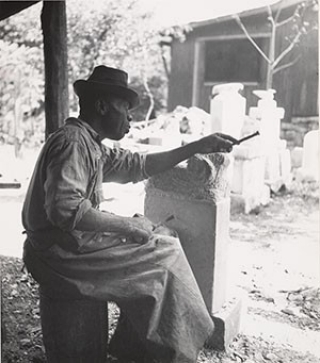Born 1874, Davidson County, Tennessee
Died 1951, Nashville, Tennessee
Born at the dawn of the Jim Crow era, William Edmondson worked for a railroad company and then a women’s hospital before beginning to make and sell tombstones from the yard outside his home in 1931. Claiming divine inspiration, he soon branched out into garden ornaments and sculpture. In 1937 Harper’s Bazaar photographer Louise Dahl-Wolfe met Edmondson and took pictures of him and his creations. When the magazine refused to feature an African American sculptor, she introduced his work to Alfred Barr, who gave him an exhibition at MoMA that year. Edmondson was the first African American and the first self-taught artist to have a solo show at MoMA , featuring twelve works, though the museum did not acquire any sculptures or include him in its “Modern Primitives” galleries (which featured mostly painters).
Edmondson carved tombstones from discarded pieces of limestone with railroad spikes and a hammer. Many of his motifs derived from African American burial traditions, and his clients came from the local community. But his economy of form and texture also attracted white patrons who associated his work with the revival of “direct carving” by sculptors like William Zorach. To this audience, Edmondson’s spontaneous working method connoted authenticity, while his minimalist forms—he claimed to carve “stingily”—recalled Brancusi’s earlier forays into direct carving. Appealing to these collectors, who often commissioned sculptures, Edmondson drew on sources such as the replica Parthenon installed in Nashville for the 1897 Tennessee Centennial Exposition.
Both Noah’s Ark and Tombstone with Bird echo the vernacular forms seen at the nearby African American Mount Ararat Cemetery. In addition to heavenly figures like Angel, Edmondson depicted pillars of the community, such as preachers and popular heroes. Jack Johnson memorializes the first African American boxer to hold the world heavyweight championship title between 1908 and 1915, known for his unprecedented success and his defiance in the face of segregation. Edmondson’s animal carvings reflect a more personal vision: Horse with Short Tail, for example, takes an imaginative, emblematic form. Edmondson’s death in 1951 occasioned a New York Times obituary, and his pioneering work won recognition during the civil rights era that led to his preeminence by the time Black Folk Art in America, 1930–1980 debuted at the Corcoran Gallery of Art in 1982.
Jenevive Nykolak
Vlach, John Michael. William Edmondson: A Retrospective. Nashville: Tennessee State Museum, 1981.
